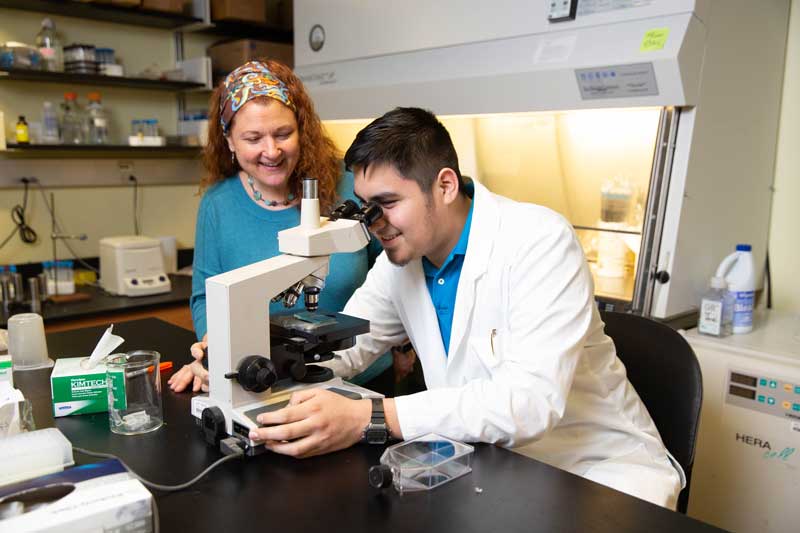
Above: Nolberto Jaramillo Jr. ’21 and associate professor of biology Jani Lewis in the lab. Below: Amaka Lawren Okorie ’16 delivering the senior oration at commencement. (SUNY Geneseo photos: Keith Walters ’11)
SUNY Geneseo’s comparatively small size pays large dividends to the growing number of students in its pre-medical and pre-health programs. Its unique combination of faculty support and mentoring, undergraduate research opportunities, curricular preparation, and collaborative atmosphere have turned Geneseo into a recognized pre-med powerhouse.
The Association of American Medical Colleges ranks Geneseo 12th in New York State for undergraduate institutions supplying 50 or more applicants to U.S. medical schools in 2020–21. The list lands Geneseo, with 60 applicants, between schools such as Carnegie Mellon University with 61 and Rutgers University with 58, both much larger institutions.
“We’ve attracted hard-working students who have earned the respect of medical schools, and they are accepting our students at high rates,” says Wendy Pogozelski, distinguished teaching professor and interim chair in chemistry and coordinator of the college’s pre-med and pre-health programs. “And Geneseo grads aren’t just applying and getting into high-ranking programs—they’re succeeding once they get there, often leading their classes and receiving prestigious fellowships.”
Faculty Support and Mentoring
Pre-med and pre-health advising are meant to be robust, explains Pogozelski. Close personal attention and active mentorship begin during a student’s freshman year. Faculty support extends to assistance with medical school applications ranging from mock interviews to essay advice. Professors’ deep familiarity with their students allows them to write detailed letters of reference.
“The main advantage of studying at Geneseo versus a larger institution is the quality of the relationships one can form with their professors,” says Nolberto Jaramillo Jr. ’21 (biology), a student in Geneseo’s 3+4 program with the New York Institute of Technology College of Osteopathic Medicine (NYITCOM). “At many large universities, getting access to busy professors is not so easy. As a minority first-generation student, I looked to my professors for guidance and knowledge, and in return, I received plenty more than I hoped for.”
Amaka Lawren Okorie ’16 (biology), who is currently in her second year at the Geisel School of Medicine at Dartmouth College, waited several years to apply to medical school. She says the support she received from Geneseo didn’t end at graduation. “This is why I’m such a proponent of small liberal arts schools,” she says. “If you’re just a number walking the hallways, no one would remember you after graduation.”
Undergraduate Research Opportunities
More than 40 percent of Geneseo undergraduates take on a research project, and they recognize the value of designing their own projects. Greater involvement in the work creates a greater sense of ownership, they report, unlike undergrads at institutions whose research projects are largely in the purview of graduate students.
Both Jaramillo and Okorie conducted research projects with associate professor of biology Jani Lewis. Jaramillo’s research poster was accepted at conferences by the American Association for Cancer Research and the Harvard Medical School Biomedical Sciences. He credits that experience with his 2019 acceptance to the DAAD RISE program, which paid all his expenses for a summer of research and travel in Germany.
Okorie, who worked with Lewis for three years, says most of her medical school colleagues didn’t have that kind of undergraduate experience. “That research got me in the door” at Dartmouth, she adds.
Curricular Preparation
Geneseo’s commitment to the program is evident in the breadth of majors in the pre-med pipeline (biology, chemistry, and neuroscience as well as the psychology and sociomedical sciences programs); the depth of available pre-med and pre-health tracks (Geneseo offers 10); the interdisciplinary course offerings in subjects ranging from medical ethics to social determinants of health and disease; and the available 3+3 and 3+4 cooperative programs with NYITCOM, SUNY Optometry, and Upstate Medical University Doctor of Physical Therapy.
“The curriculum is structured so concepts are reinforced in course after course,” says Pogozelski. “Students leave with a deep understanding of the material.”
To complement the classroom training, Geneseo offers an increasing array of potential clinical opportunities close by, including a new 50,000-sq.-ft. multi-specialty medical facility and surgery center within three miles of campus. Clinical opportunities also extend to pre-vet students, who benefit from Geneseo’s proximity to horse and dairy farms, an equine clinic, and large veterinary practices.
Collaborative Atmosphere
Geneseo provides a more collaborative than competitive atmosphere, says Pogozelski. Senior students take pride in helping to mentor underclassmen, and the College offers both a professional pre-medical fraternity (Phi Delta Epsilon), a Minority Association of Premedical Students chapter, and a number of other clubs geared to support students with pre-med interests. Students also benefit from Geneseo’s network of alumni in health professions, who frequently share their time to offer advice and encouragement.
Those networking opportunities are critical to success, says Okorie, who pays it forward by currently mentoring new medical students. “It’s hard to do any of this on your own.”
Questions about Geneseo’s pre-medical or pre-health programs? Contact Wendy Pogozelski, program coordinator, at pogozels@geneseo.edu or 585-245-5453.
Related Stories
James Oigara Leads Workshop for Teaching with Primary Sources
Geneseo Alum Alex Chin ’17 Earns Prestigious APS 2026 GCCM Award
Barsema Earns Constructive Dialogue Facilitator Certification
Education Faculty Member Publishes STEM Curriculum Guide for Elementary Teachers
Book Talk w/ Dr. Jovana Babovic, Assoc. Prof. of History – The Youngest Yugoslavs
